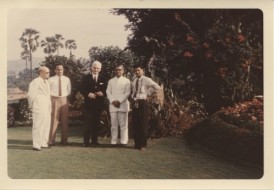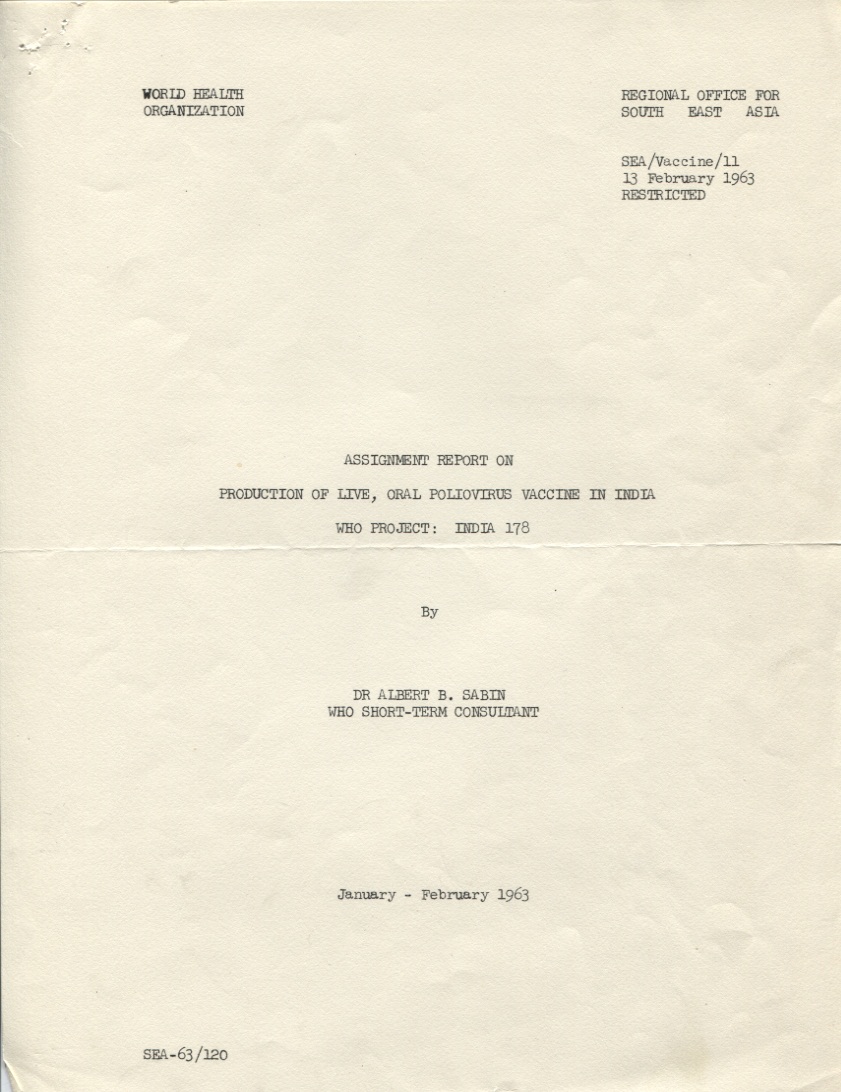I recently read an article on the BBC News website, which stated that India had not reported case of polio in the country for a whole year, from January 13, 2011 to January 12, 2012. According to the World Health Organization, India was once considered “the world’s epicenter of polio.” Just a couple years ago, there were 741 reported cases in the country. The fight against polio in India has made significant strides in just a couple of years. The use of the oral polio vaccine, originally developed by Dr. Sabin, has helped India become polio-free for the first time.
The Hauck Center for the Albert B. Sabin Archives contains a good amount of materials related to the fight against polio in India. The collection includes correspondence between scientists working on polio research and the oral polio vaccine, documents written by Dr. Sabin and others on the status of polio in India, and photographs from his travel there. The photograph seen above is from his trip to India and Ceylon in 1963.
From reading the materials Dr. Sabin kept in reference to his 1963 trip to India, it is evident that the country had to overcome various hurdles to reach this successful milestone almost 50 years later. Here is an example:
In October 1962, Dr. Sabin received a letter from Dr. W. Charles Cockburn, Chief Medical Director of the World Health Organization, regarding a possible trip to India to assist the government with the production of the oral poliomyelitis vaccine. Dr. Cockburn stated, “[…] I am pleased to offer you a WHO consultantship for a visit to India sometime during the next six months so that they can have the benefit of your invaluable knowledge on how they should set up their production laboratories at Bombay and Coonoor, and on related questions of choice of equipment and training of personnel.”[1] After several letters back and forth between Dr. Sabin and Dr. Cockburn, it was finally confirmed that he would be in India from January 14-February 3, 1963. In writing to a colleague in India, he noted, “I shall bring with me, in dry ice, the poliovirus vaccine seed material and also some cultures of the stable line of cercopithecus BS-C-1 cells.”[2] While there, Dr. Sabin toured several facilities and met with many scientists about the vaccine. He also made suggestions to the Indian government regarding how they should implement an oral vaccination program for their country.
After his return from India, Dr. Sabin wrote “Assignment Report on Production of Live, Oral Poliovirus Vaccine in India – January-February 1963,” which described his trip and provided recommendations for vaccine production. One of the things he noted on his trip were, “The Pasteur Institute at Coonoor is, in the writer’s opinion, qualified to produce this vaccine and would be ready to start as soon as the necessary equipment is made available to them.” He thought that once the facility was at full capacity, they would be able to produce 100 million doses of all three vaccine types in five months.[3]
However, it appears that the Pasteur Institute encountered some roadblocks to producing the oral polio vaccine right away. In a letter from Dr. Sabin to Dr. Eugene Campbell of United States Agency for International Development (USAID), he wrote, “In a previous letter, Dr. Veeraraghavan [of the Pasteur Institute] said that USAID ‘authorities’ had told him that the autoclaves which are necessary for this [oral polio vaccine] work would have to be fabricated in India and that it would take 6 to 10 months after the application had been approved before they would be ready.” Dr. Sabin urged USAID to try to make the autoclaves available to the Pasteur Institute sooner, so they could begin their work on the vaccine.[4]
In February 1964, Dr. Sabin received a letter from the World Health Organization, informing him that the equipment that was requested would be installed in the Pasteur Institute by July 1964 and they hoped to have batches of the vaccine prepared by September 1964.[5]
In July 1966, Dr. P.V. Gharpure sent Dr. Sabin a letter containing a copy of a press report in The Hindu. According to the report, the polio vaccine unit at the Pasteur Institute opened on July 4, 1966. Dr. Veeraraghavan noted that the Institute planned to give children under 7 years of age, which he estimated to be around 50 million children in the country, two doses of the oral polio vaccine. They planned to have the vaccine ready by April 1967.[6]
The creation of facilities in India specifically for oral polio vaccine production, such as the Pasteur Institute, required properly trained scientists and facilities, which required time and funding sources. It wasn’t until 1970 that the Pasteur Institute was able to produce the trivalent oral polio vaccine in India.[7] After that, it is unclear to me what happened with the Pasteur Institute and its’ oral polio vaccine. However, it is evident from this example that the path to eradicating polio would be a difficult one, requiring much effort from many.
It took a huge amount of effort to help India achieve its’ new status as “polio-free” for one year. The country held two “National Immunization Days” in 2011, administering over 225,000,000 doses of the vaccine. The Indian government, along with the partners of the Global Polio Eradication Initiative, played major roles in the recent success in India.[8] Even though Dr. Sabin isn’t here to see it, I am sure he would have been pleased.
References
Note: All of the documents mentioned here can be found in Series 7 – Oral Poliovirus Vaccine, Sub-Series Correspondence, Box 9, Folder 7 – India 1962-1973, unless indicated.
[1] Letter from Dr. Cockburn to Dr. Sabin, 9 October 1962.
[2] Letter from Dr. Sabin to Dr. Jhala, 4 January 1963.
[3] Report by Dr. Sabin for the World Health Organization called, “Assignment Report on Production of Live, Oral Poliovirus Vaccine in India – January-February 1963.”
[4] Letter from Dr. Sabin to Dr. Campbell, 13 June 1963.
[5] Letter from Dr. C. Mani to Dr. Sabin, 27 February 1964.
[6] Letter from Dr. Gharpure to Dr. Sabin, 22 July 1966.
[7] Pasteur Institute of India’s website, accessed 01 February 2012. The website states that they were the first to produce the vaccine in India.
[8] Global Polio Eradication Initiative, “Polio in India: Fact Sheet,” accessed 01 February 2012.
In 2010, the University of Cincinnati Libraries received a $314,258 grant from the National Endowment for the Humanities (NEH) to digitize the correspondence and photographs of Dr. Albert B. Sabin. This digitization project has been designated a NEH “We the People” project, an initiative to encourage and strengthen the teaching, study, and understanding of American history and culture through the support of projects that explore significant events and themes in our nation’s history and culture and that advance knowledge of the principles that define America. Any views, findings, conclusions, or recommendations expressed in this blog do not necessarily reflect those of the National Endowment for the Humanities.


